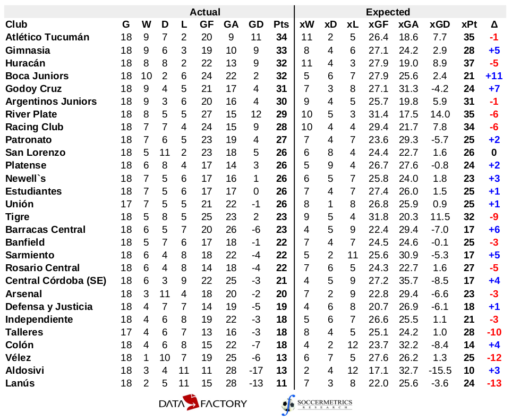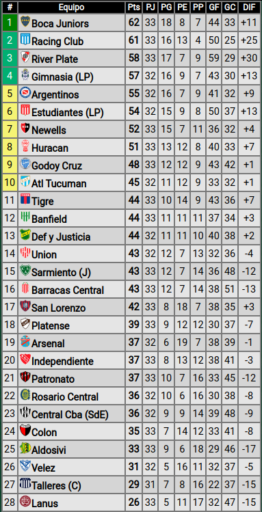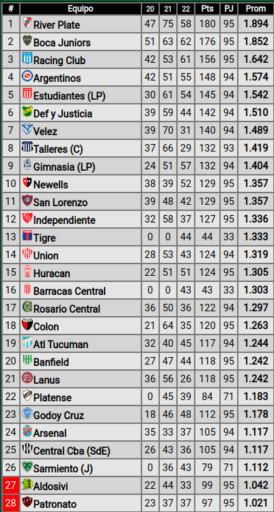Argentina Primera División 2022: A two-thirds of the season review
Categories: Competition Analysis
This was supposed to be a mid-season check-in of Argentina’s Primera División championship, also called the Liga Profesional de Fútbol AFA, or commercially the Torneo Binance. One thing and then another happened, and before you knew it, two-thirds of the season has gone. It’s time to write that post before the entire season is over.
This season’s tournament format is part of AFA’s slow, slow march toward a more manageable 20 team top division (which, believe or not, was once an AFA goal as recently as 20 years ago). There are 28 teams in Primera, and every team will play each other once for an odd 27 matches. The winner of the tournament advances to the Copa Libertadores group stage, to be joined by Boca Juniors, who won the Copa de la Liga, and the winner of the Copa Argentina. The other continental cup places are determined from aggregate totals of the initial phase of the Copa de la Liga and the full season of the Liga Profesional. After two years of suspended relegations because of the Covid-19 pandemic, two clubs will be relegated this season based on the three top division seasons.
Here is how the table of the Liga Profesional looks after Round 18, which concluded last Sunday:

The annualized table, which determines the remainder of the Libertadores and Sudamericana places, looks like this courtesy of Argentine website Promiedos. It’s a live table, so it includes matches from Round 19 that is ongoing.

The live relegation table from Promiedos looks like this:

This has been an odd tournament in that, until this weekend, the Big Five teams — Boca Juniors, River Plate, Independiente, Racing Club, and San Lorenzo — have taken a back seat in the league. Instead, you see plucky upstarts such as Atlético Tucumán, Gimnasia (La Plata), Huracán, Godoy Cruz, Unión (Santa Fe), and Argentinos Juniors contend for the top spots. Even more odd is to see the pluckiest of upstarts — Defensa y Justicia — struggle to the point that their manager Sebastián Beccacece departed ahead of schedule.
There are various reasons why the Big Five have struggled. Boca were occupied with Copa Libertadores and were coming off a Copa de la Liga high, but suffered two embarrassing home defeats that cost Sebastián Battaglia his job. After a rough seven match patch during the end of Battaglia’s tenure and the start of Hugo Ibarra’s, they’ve righted the ship with four consecutive wins including an always important win the the Superclásico. River Plate were also busy with Copa Libertadores, didn’t start the league well (two wins in their first seven), and had to deal with Manchester City calling up Julián Álvarez, who was having arguably the best season of a player in South American competitions this year. Independiente have been a mess off the field and the results have shown on the field (just four wins). Racing was challenging the top spots but have suffered from lack of consistency: they have yet to win consecutive matches. San Lorenzo have drawn, and drawn, and drawn…and then drawn some more.
Also contributing to the oddness of this championship is that the teams at the top of the table are not highly rated in the advanced metrics, at least offensively.
Tigre and River currently lead the division of expected goals per 90 minutes with 1.61 and 1.60, respectively. River are just outside the leading pack of teams, but Tigre are mired in mid-table. A closer look at the goal scoring charts reveals that, as of last Sunday, no River player has scored more than four goals (Julián Álvarez, who left in July, scored three). As for Tigre, Mateo Retegui leads the league with 13 goals, but no other Tigre player has scored more than three.
Turning to the leading teams, Huracán and Boca have generated 1.40 xG/90, Gimnasia 1.38, and Atlético Tucumán 1.34. Of those teams, only Huracán and Atlético Tucumán have a goalscorer with more than four goals (Ramiro Correa of Atlético, and Franco Cristaldo of Huracán). Huracán does stand out for having seven penalty kicks in their favor, tied with San Lorenzo for most in the division. Cristaldo has converted on five of them.
The expected goals metrics see more of the leading teams at the top, but there are some surprises. Once again, River have allowed the fewest expected goals (17.46), which translates to a league-leading 0.89 xGA/90. The next leading teams in expected goals allowed per 90 are Atlético Tucumán (0.95), Huracán (0.97), and Argentinos Juniors (0.99), respectively. Boca Juniors lie mid-table with 1.28 xGA/90, but that figure is inflated by the fact that they have had seven penalty calls go against them. Fortunately, Boca have Agustín Rossi on their team.
At the relegation end of the table, Aldosivi look doomed for the drop. They have been bottom or next-to-bottom in the league, and they rank near bottom in xG/90 and xGA/90. Patronato have had a good season and achieved some memorable victories (the 3-0 against Boca will live long in the memory banks), but they may have too much of a deficit to overcome. We might be seeing one of the cruelties of Argentina’s relegation system, but it is a system that creates its own constituency among minor and regional teams that have figured out how to stay in Primera. Patronato’s lifeline is that their xGA metrics are better than Arsenal and Central Córdoba, who could get drawn into the relegation scrap with a couple of losses.
As we enter the last third of the season, Boca appear to be playing something close to their best football of the season, so most pundits will expect them to win the championship ultimately. All of the leaders have at least one match among their closing nine that seem to be eliminators (Boca vs Huracán, Argentinos vs Atlético Tucumán, Argentinos vs River, Gimnasia vs Boca, and others). But I believe the romantics would like to see one of the “smaller” clubs like Huracán, Gimnasia, Argentinos, or Atlético go all the way. Those four have their reasons — Huracán attract a lot of sentimentalists, Gimnasia were Diego’s final stop, Argentinos are a neighborhood club with a legendary academy — but the idea of an Interior club winning the title is an exciting one. And with “Santo” Lucas Pusineri on the touchlines, Manuel Capasso in defense, Joaquín Pereyra, Guillermo Acosta in the middle, and Ramiro Carrera creating and scoring goals, el Decano have a chance.
Match data used to prepare this post has been provided by DataFactory Latinoaméricano.

